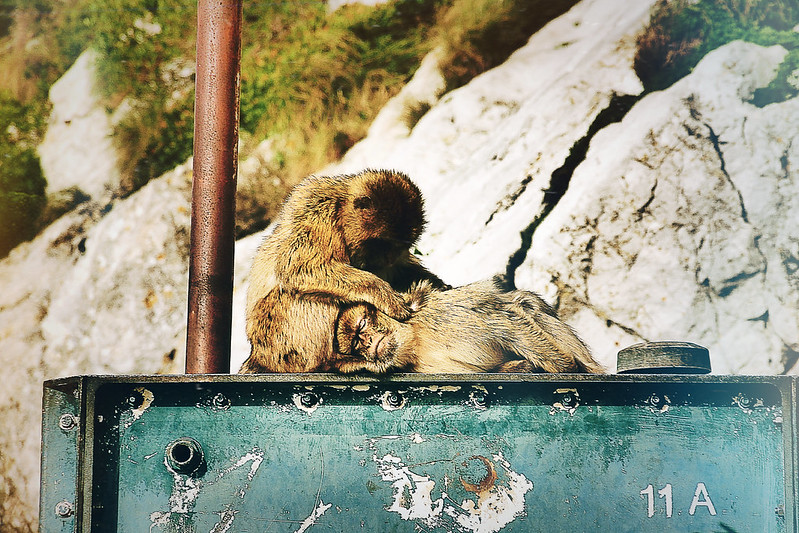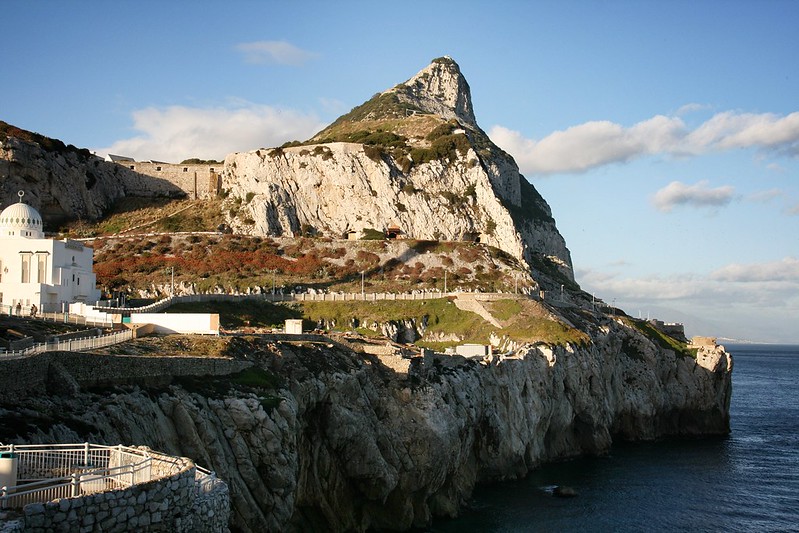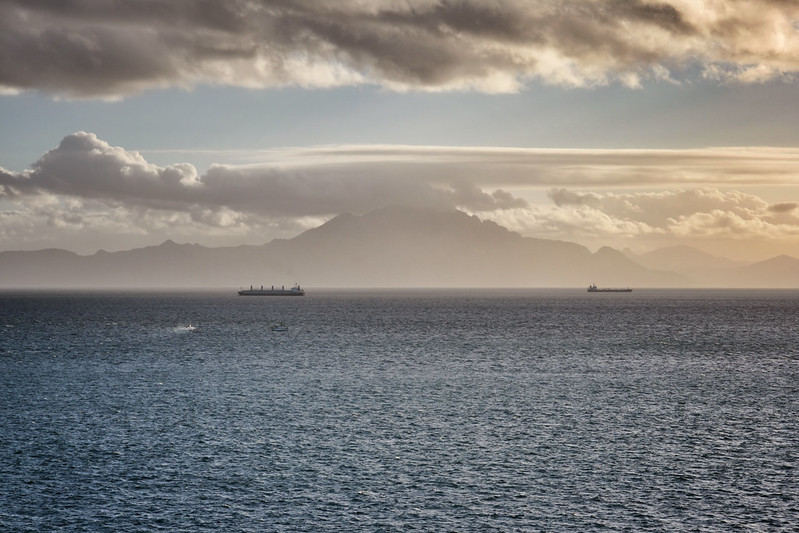I've always had a significant affinity towards enclaves, exclaves and certain territorial dependencies. Therefore today I'd like to tell you about a magic place called... Gibraltar. Well, there's no real magic except the pilots' skills regarding landing and takeoff procedures at Gibraltar International Airport. The British Overseas Territory (and British has tons of them (to be precise: 14) scattered within the Atlantic, Indian and Pacific Ocean, in the Mediterranean Sea and between North and South America).
Even though Gibraltar is a British Overseas Territory it is linked by land to mainland Europe in southern Spain. Population in 2012 was estimated to around 30 000 people. Its size is 6.8 km²: it would fit into Liechtenstein, also in Andorra, definitely in Singapore (well, actually in Singapore's International Airport Changi) and in most big US cities. The size has its plus points: exploring Gibraltar is doable within a day!
+ Getting into Gibraltar
Gibraltar has an international airport (GIB) with a single runway which — despite its length of less han 2 km — takes up lots of space. British airways, easyjet and Monarch Airlines serve London, Manchester, Birmingham, Bristol, etc. Royal Air Maroc has weekly flights to Tangier. Due to the size of the territory only small to medium aircraft (Boeing 737 and Airbus A320) are allowed to land there.
Entering Gibraltar over land is more interesting. Local intercity buses connect several Spanish cities (Málaga, Marbella, Granada, Estepona, Valencia, Barcelona) with the Spanish town next to Gibraltar: La Línea de la Concepción. The tiny bus station that has the flair of a provincial bus station somewhere in Eastern Europe is within walking distance to the Gibraltar border point (just walk towards the Rock...). Gibraltar itself doesn't have an intercity bus or rail station. You can check bus connections, timetables and prices to/from Gibraltar on the Avanzabus website. A one-way trip from Málaga to La Línea is around 16 Euro/person.
Crossing the border requires a valid passport and eventually a valid UK visa. When I entered Gibraltar the waiting queue and the check took less than a minute.
By car would require a valid document for the vehicle. Sometimes long waiting queues, I don't recommend it despite the driving rules on the right side as in the rest of continental Europe.
Seeing Gibraltar in a day
+ Sightseeing map of Gibraltar (walking routes included)
1. Gibraltar International airport
Every person entering this British Overseas Territory is required to pass through the airport: Don't worry, you won't be forced to buy a flight ticket! Since the runway cuts across the country and digging a tunnel would cost too much people and vehicles are required to walk or drive literally through the runway to reach Gibraltar. The number of flights is limited which makes crossing easy at nearly any time. When a flight arrives or departs barriers on both sides of the runway are lowered down and airport personnel checks the runway for any objects. After take off or landing barriers are lifted and traffic can cross. Walking outside the designated areas or even stopping is strictly forbidden and can lead to serious fines because it can be interpreted as "endangering of air traffic". When I walked across the runway photographing was okay as far as it didn't include any suspicious behavior. Mind that rain water puddles can build up on the runway sometimes. Aircraft don't mind it but nobody wants to walk with wet socks afterwards...
There's a funny story about the airport which our driver told us: when they were kids they used to play soccer at the nearby soccer fields just a few yards next to the runway. Back then airplanes didn't use ILS (Instrumental Landing System) and landed by visual flight rules. So when a plane was in sight the lights at the stadium had to be turned off because of the danger of bedazzling the pilots which forced the young Ronaldos and Messis to hold out in the darkness till the aircraft reached its parking position. The game was resumed... till the next landing.
A few years ago there used to be dispute between Britain and Spain which lead to a ban of usage of Spanish airspace by British jets. They were forced to approach Gibraltar over Portugal.
2. Cradle of History Monument & Gibraltar Memorial
The Cradle of History Monument welcomes us as we exit the airport area on the other side. The monument is shaped like the Rock and depicts Gibraltar's history.
Further down Winston Churchill Ave we will spot the Gibraltar Cross of Sacrifice to the left. It is commemorating the war victims of the British Empire. The cross (and the roundabout next to it) is a good reference point of our itinerary.
+ Do you speak... Llanito?
Many Gibraltarians speak (beside English) a special version of Spanish called Llanito. It is a mixture of Spanish, English with a tone of Hebrew, Portuguese and Maltese. When speaking Llanito Gibraltarians often switch between Spanish and English. Instead of "Dude,..." they say "Hombre..." continuing then in English. Some modern words are entirely taken from English, others from Spanish. Spanish people in the area refer to Gibraltarians as "Llanitos" (fem. "Llanitas"). I personally find the language very pleasant!
3. Main St. and Grand Casemates Square
Continue along Winston Churchill Ave and while feeling more and more British don't forget to pull to the left into Grand Casemates Square (named after the fortified barracks to the one side of the square). After crossing the square we are in the pedestrian zone of Gibraltar. Quite British, huh?!
Main Street is a pedestrian street, at some point however it is open to traffic or transforms into a regular street.
On our way we will encounter places of worship and of "foodship". Don't hesitate to stop for a bite: The Gibraltarian cuisine may have its influences from Britain but it also features some genuine Andalusian and Maltese taste!
+ Paying in Gibraltar
Even though Gibraltar is a British Overseas Territory the official currency is the Gibraltar Pound Sterling (GIP, £). The exchange rate is however 1:1 with the British Pound Sterling (GBP, £). Both currencies can be used for payment in Gibraltar. Mind that the Gibraltar Pound Sterling ("monkey money" as some local called it) is not accapted in Britain! Some banks in the UK change Gibraltar notes into UK notes at no cost though. Euros are widely accepted but at bad exchange rates. Payments with credit cards are handled without any troubles.
4. Cathedral of St. Mary the Crowned and Cathedral of Holy Trinity
The Cathedral of St. Mary the Crowned was built on the site of a former mosque in 1462. The Cathedral of Holy Trinity was built in a Moorish Revival style and is led by the Diocese of Gibraltar in Europe.
5. Cable Car
By the end of Main St. at the Referendum Gates you'll find Trafalgar Sports Bar (a good place to grab something to eat) and at the back of it Queens Cinema. Opposite to it is the Grand Parade, a huge parking lot surrounding the Lower Cable Car station of Gibraltar. Next to it are the Alameda Botanical Gardens. The cable car will bring you to the top of the Rock with an optional intermediate stop at St. Michael's Cave/Apes Den. The cable car runs daily (every 10 min.) and opens at 9.30am. One-way ticket is GBP 9.50 (you can walk down, it's a looong walk), a return ticket is GBP 12 (discounts for students and kids & online-tickets available, check the pricing here). Last car may vary according to season, check here for more info. The cable car service doesn't operate on days with very bad weather and/or on gusty days (the later occurs from time to time due to the Mediterranean climate) but this can be also a blessing because there are local minibus drivers in front of the lower station who would offer you a lift to the top station, a guided tour by a local guy for the same price of the return ticket! You'll be able to see also the Ape Den, the St. Michael's Cave, the Great Siege Tunnels... So it's quite a good deal.
+ What does Gibraltar do for a living?
Gibraltar's economy is mostly oriented towards the tertiary sector: services and tourism. But also the Internet! Many online bet and gambling companies are registered in Gibraltar and are profiting from its favorable tax system.
6. The Rock
This is the main natural landmark of Gibraltar: the famous Gibraltar Rock. It can be seen from Spain and even from neighboring Africa. Narrow roads lead to the top (also a cable car, see previous point). Along the road you would see lots of loop rings fixed into the ground. These were used to secure the cannons that were dragged to the top of the rock. Gibraltar had a very strategic role in the Battle of Trafalgar but also in the World War II, since Germany was trying to capture the Rock! Therefore the landmark was fortified.
7. Ape's Den & Barbary macaques
There's one thing that inevitably belongs to Gibraltar: It's hairy, quick-moving, cheeky and sneaky: The Barbary macaques! The Rock inhabits the biggest monkey colony in Europe. There are around 300 macaques living in Gibraltar, mostly at the Rock. This type of monkey used to live in Gibraltar long before it became British in 1704. Decades ago there used to be an appointed military officer from the Royal Navy whose job was to take care of the animals. Every newborn was named after a famous British officer, general, etc. Gibraltar even has an extra government budget for food and health care of the macaques!
Tourists love taking pictures and petting the monos, as locals call them. Mind however that these little guys are quite smart and are waiting for you to distract so they can grab your bag of food, your hat or even your mobile phone thinking it might be digestible... You should probably keep any loose objects in the car (or close to you).
+ Urban legend about the macaques
There used to be a legend saying that if the macaques disappeared from Gibraltar the colony wouldn't remain under British Rule anymore. As the number of macaques dropped at around seven during WWII British Prime Minister Sir Winston Churchill ordered more monkeys to be brought from Morocco and Algeria.
8. Saint Michael's Cave
The cave is actually a network of several caves. The interior is really beautiful and reminded me of a natural concert hall. During WWII the cave was intended to be a military hospital but it was never used as such.
9. Great Siege Tunnels
Another stunning military site are the Great Siege Tunnels in the north part of Gibraltar. The were extensively used in the Great Siege of Gibraltar from 1779 till 1783 as Spain and France unsuccessfully tried to take Gibraltar from Britain. From the tunnels you have a splendid view to Gibraltar airport and Spain. On your way down you might have a stop at the World War II Tunnels.
+ Public transport of Gibraltar
Gibraltar's public transportation is limited to a good bus network (well, and a cable car). Buses are clean, comfortable and drivers are very happy to help. Since traffic is right-sided (just as in the rest of continental Europe) bus stops are on the right side of the road contrary to anyone's London experience... One bus ride costs 1.50 GBP (or 2 EUR). A day pass (unlimited rides) costs just 2.25 GBP (3 EUR). Children and seniors pay less. The Gibraltar Bus Company provides more information about the network, pricing and routes (featuring a network PDF with detailed desciption of bus stops). There is no bus service after around 9 pm and at night.
10. Europa Point, Trinity Lighthouse
From the cable car station we head back to Queens Cinema at Elliots Way (200 m north of the lower cable car station). There is a bus stop serviced by bus route #2 which would bring us to the southernmost point of Gibraltar: Europa point.
Next to Europe Point you will see the southernmost mosque in mainland Europe: Mosque of Two Holy Custodians (also Ibrahim-al-Ibrahim Mosque): It serves to 4% of Gibraltar's population who are Muslims (that would be around 1000 people).
The view from the Europa park and the nearby Trinity Lighthouse opens a beautiful view to the Strait of Gibraltar (the natural border between the Mediterranean Sea and the Atlantic Ocean). On a sunny fog-free day Africa is visible and you can spot the Atlas Mountains in Morocco. Africa is less than 15 km (9 mi) away, ferries from the Spanish town of Algeciras need less than 40 minutes to reach the continent.
Bus #2 will bring us back to Grand Casemates Square. From there we can just walk (or take the next bus #5 that runs every 10 minutes to the airport) to our (air)port of entry and leave Gibraltar.
+ Spain... in Africa
Spain has three exclaves. An exclave is a small piece of territory belonging to a particular country but surrounded by a different state. While the Spanish exclave of Llívia is surrounded by France, the other two are in... Africa.
The tiny exclave of Ceuta is just south of Gibraltar and bordering entirely with Morocco. It can be reached via a ferry service from Algeciras, a port town next to Gibraltar and La Línea de la Concepción (journey time Algeciras-Ceuta is around 1 hour, several ferries daily by FRS and Balearia, pricing varies around 60-70 EUR for a return ticket without a vehicle and without a "Ceuta Resident" discount).
The exclave of Mellila is bigger than Ceuta and also surrounded by Morocco, however south-east of Málaga, across the Mediterranean Sea. The exclave has its own regional airport and is linked to mainland Spain (Málaga, Granada, Madrid, etc.) by Iberia Regional/Air Nostrum and Air Europa. The next closest international airport is in Morocco (Nador, ca. 35 km) which is also served by low-cost airlines like Germanwings (Cologne) and Ryanair (Barcelona, Paris Beauvais, Brussels Charleroi, Marseille, Frankfurt Hahn).
Both exclaves are fighting illegal immigration from Morocco by guarding the border (EU outer border) and errecting high fences along it. Nevertheless worth a visit!
I hope you enjoyed the day-trip to this tiny bit of Britain! Cheers, mate!




